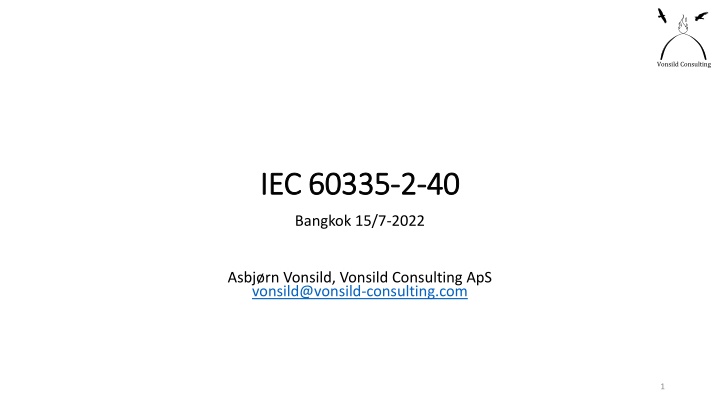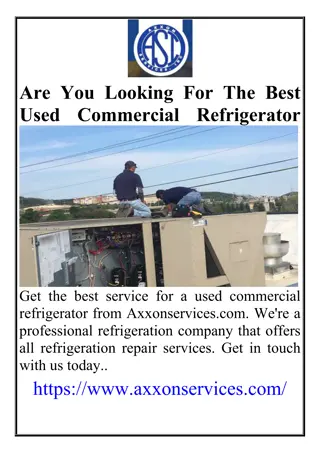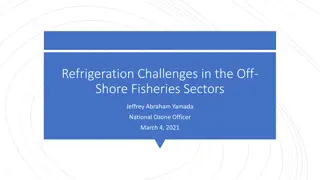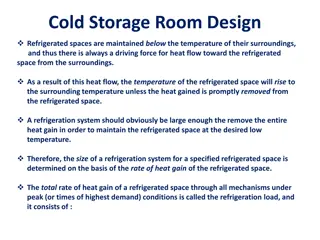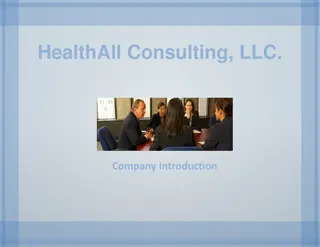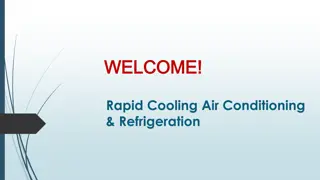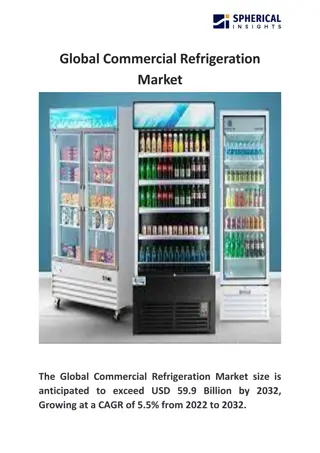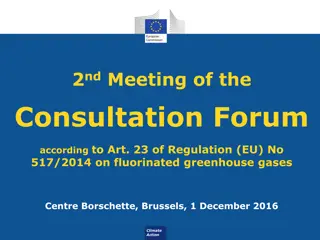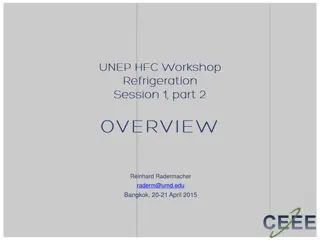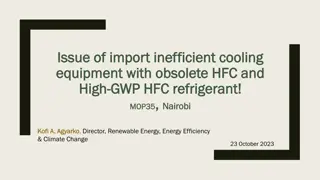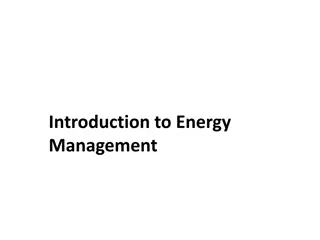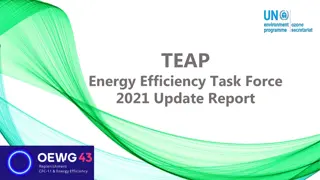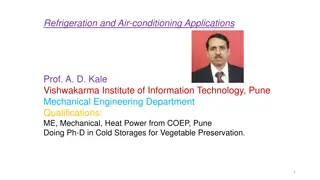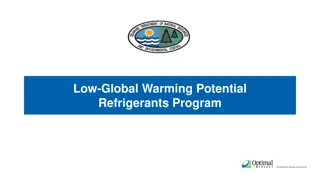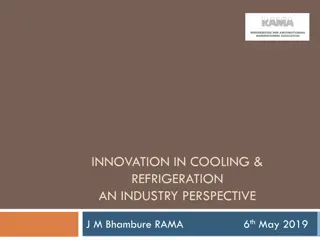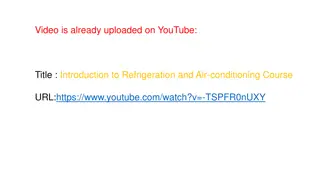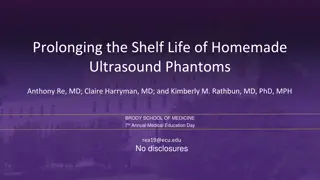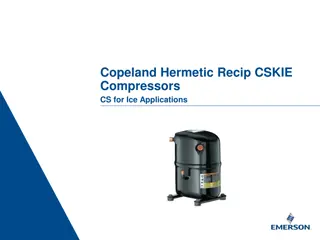Asbjørn Vonsild Consulting: Expert in Refrigeration Standards and Flammable Refrigerants
Asbjørn Vonsild Consulting, led by Asbjørn Vonsild, specializes in standards and legislation within refrigeration, A/C, and heat pumps, particularly focusing on flammable refrigerants. As a key figure in various committees and working groups related to refrigeration safety standards, Asbjørn Vonsild is actively involved in shaping regulations and guidelines to enable the use of flammable refrigerants in a safe and efficient manner. The consultancy's core competencies lie in promoting refrigeration technologies that adhere to the latest safety standards while maximizing environmental sustainability.
Download Presentation

Please find below an Image/Link to download the presentation.
The content on the website is provided AS IS for your information and personal use only. It may not be sold, licensed, or shared on other websites without obtaining consent from the author.If you encounter any issues during the download, it is possible that the publisher has removed the file from their server.
You are allowed to download the files provided on this website for personal or commercial use, subject to the condition that they are used lawfully. All files are the property of their respective owners.
The content on the website is provided AS IS for your information and personal use only. It may not be sold, licensed, or shared on other websites without obtaining consent from the author.
E N D
Presentation Transcript
Vonsild Consulting IEC 60335 IEC 60335- -2 2- -40 40 Bangkok 15/7-2022 Asbj rn Vonsild, Vonsild Consulting ApS vonsild@vonsild-consulting.com 1
Brief introduction of Asbjrn Vonsild Consulting Core competencies: Standards and legislation within refrigeration, A/C and heat pumps. Flammable refrigerants. Asbj rn Vonsild Vonsild Consulting ApS E-mail: Vonsild@Vonsild-consulting.com Tel.: +45 2372 5559 External roles: Convenor of WG21 the working group for IEC 60335-2-40 Ed. 7. Member and coming chair of IEC/TC61D/SC61D, the steering committee for IEC 60335-2-40. Chair of the Danish mirror committee for standards within large refrigeration systems (s251). Member of CEN/TC182/TC86 and CEN/TC182, the working group and steering committee for EN 378. Member of ISO/TC86/SC1/WG1 and ISO/TC86/SC1, the working group and steering committee for ISO 5149. Member of the Danish mirror committee for standards within household refrigeration systems (s561). Member of RTOC (Refrigerant Technical Options Committee), the advisory group on refrigerants for the Montreal Protocol. Lead author on the chapter for refrigerant properties. 2
IEC 60335-2-40 Ed. 7 Vonsild Consulting IEC 60335-2-40 Ed. 7 is the new IEC safety standard for A/C, heat pumps, and dehumidifiers. The standard enables flammable refrigerants (A2L, A2, and A3) in many applications, by increasing allowed refrigerant charges A3 will be focus of today, e.g. Propane/R290 The proposal applies mitigation measures to increase charge limits without increasing risk: o Releasable charge: Only refrigerant actually leaked will create a hazard o Airflow: Air mixing with leaked refrigerant can keep the concentration below the lower flammability limit o Enhanced tightness: Additional design measures can limit the size of leaks, and only large leaks are dangerous. Common A3 refrigerants: R290 Propane R600a Isobutane R1270 Propene IEC 60335-2-40 Ed. 7 was published 25thof May 2022. 3
Motivation for IEC 60335-2-40 Ed. 7 - Example Vonsild Consulting Charge limit for A2L Charge needed for cooling the room Hydrocarbons have very low GWP and good efficiency, but are also highly flammable (A3). Charge Example Residential A/C : For propane (a hydrocarbon) the refrigerant charge is a little too low in -2-40 to produce high capacity high efficiency units Added mitigation measures could keep the current risk level, while allowing for larger refrigerant charges Charge limit for A3 In June 2015 it was agreed at the SC61D meeting in Washington to start WG16 to address A2/A3 refrigerants. Room Area Range for residential room A/C 4
WG16: Mainly hydrocarbons .2015 September, London, UK. .2015 December, Frankfurt, Germany .2016 March, Chenzhen, China .2016 June, Copenhagen, Denmark .2016 September, London .2016 December Hangzhou, China .2017 March, Copenhagen, Denmark .2017 June, Wilmington, Delaware, US .2017 September, Aachen, Germany .2018 January, Chengdu, China .2018 April, London, UK .2018 June, Brugge, Belgium 2018 September, Stratford, UK 2018 October, Bhushan, South Korea 2019 January, Geneva, Switzerland 2019 March, Shanghai, China 2019 May, Vienna, Austria Vonsild Consulting Meet every 2-3 months 50 Experts 500 Documents 1 Committee Draft + 2 Document for Comments released +1 small DC Added WG9 15 Countries AU, BE, CN, DE, DK, FR, GB, IN, IT, JP, KR, MY, RS, SE, US 17 Meetings held WG21 2018 October: WG16 was extended with A2L refrigerants by merging with WG9 2019 June: WG16 transformed into WG21 with responsibility for next edition of -2-40 5
WG21: Publish next -2-40 edition Vonsild Consulting .2019 August, Stratford, UK 2019 September, Houston, USA 2019 October, Shanghai, China 2019 November, web meeting 2019 December, web meeting 2020 January, web meeting 2020 February, Houston, USA 2020 April, web meeting 2020 May, 4 web meetings! Web meetings: 2020 September 2020 November 2020 December 2021 January 5th 2021 January 26th 2020 February 2020 March 8th 2020 March 25th 2021 April Meet every 1 months 55 Experts 520 Documents CDV finalized: 1stvote 2021 May 2021 June 1st 2021 June 21st 2021 July 2021 August 2021 September 2021 October 2021 November 2021 December 2 Committee Draft for Vote + Prepared 1 Final Draft IEC Standard 17 Countries AU, BE, CH, CN, CZ, DE, DK, FR, GB, IT, JP, KR, NL, NO, MY, SE, US 30 Meetings FDIS finalized: Final vote 6
Detailed time plan for publication of Ed. 7 Vonsild Consulting Draft FDIS for IEC Dec 2021 Publication May 2022 The standard passed Final Vote 29th of April 2022 with no opposition. 2022 2020 2021 2022 Publication was 25thof May 2022 EN-version is expected to take 2-3 years: o Develop A11 Amendment o Pass two votes in CENELEC o Get A11 approved by EU HAS consultant o Get 60335-2-40 Ed.7 + A11 published as a harmonized standard o But like IEC 60335-2-89 it is possible to apply the IEC standard in EU until it is harmonized Publication 30-04-2022 - 25-05-2022 National Committees for approval of FDIS (VOTING) 18-03-2022 - 29-04-2022 Preparation of FDIS by SC61D and IEC 17-12-2021 - 17-03-2022 Review of comments and preparation of Final Draft 30-10-2020 - 16-12-2022 7
Charge limits Vonsild Consulting Safety is at least as good as previous edition o Larger charges of A3 refrigerants are linked to o requirements for additional mitigation measures Previous charge limits are 20 years old Upper limits not changed, what is new is the ability to utilize the upper limits with additional mitigation measures: o 988 g R290 for indoor systems (and splits) NOTE: Ventilated enclosures allows 4940g, but this is unchanged for 20 years. o 4940 g R290 for outdoor systems (systems which cannot leak to the indoors) Competence of service technicians is not covered in IEC 60335-2-40 (it belongs to EN 13313 soon to be ISO 22712), but it is a topic worth paying special attention to! 8
Releasable charge Vonsild Consulting The amount of charge released to occupied space can be limited by added mitigation means (pump-down, shut-off valves, or whatever you come up with) Only the refrigerant that leaks creates a hazard Test: 1. Run system for 30 min in the operating mode that gives highest releasable charge (compressor off, cooling or heating mode) 2. Simulate a leak for 4 hours (test 2 different leak sizes for systems which actively detects a leak) 3. Measure what is left in the system 9
Airflow Vonsild Consulting When there is a leak there is always a flammable region in space With sufficient airflow this region will not extend to the floor or opposing walls New approach based on air jet theory has been introduced for A2/A3 refrigerants CFD simulations and experiments have being used for evaluation 10
Enhanced tightness Vonsild Consulting The worst case leak rate to be covered by the standard depends on what is expected. Airflow formula: 1/4???3/4 ?1/4 ? ?,???=8.1 ??? ???? ?? 1 ? F#1: With added construction requirements a lower worst case leak rate can be assumed (concept is already used for A2L) leading to: o Lower airflow requirements (because it is easier to dilute the leak) o Higher acceptable charge sizes (because leaked refrigerant is more likely to be better distributed in the room) 3/4 5 ??? ???? 1/8 ??? 1 ? 5/8 ? ?,???= F#2: ? 11
Try to play with charge limit calculations! Vonsild Consulting Excel sheet for charge limit calculations: https://www.vonsild-consulting.com/resources Warning: This is to support the use of Ed. 7, it cannot be applied without reading all the requirements in the IEC document! If there are any mistakes, then the IEC document applies. 12
Propane example, floor mounted air-to-air Vonsild Consulting IEC 60335-2-40 Ed. 6 IEC 60335-2-40 Ed. 7 1 1 1 0,8 0,8 0,8 Allowed charge (kg) Allowed charge (kg) Allowed charge (kg) 0,6 0,6 0,6 0,4 0,4 0,4 0,2 0,2 0,2 No room size requirement system No room size requirement system No room size requirement system 0 0 0 0 10 20 30 40 50 60 70 0 0 10 10 20 20 30 30 40 40 50 50 60 60 70 70 Area (m2) Area (m2) Area (m2) Charge limits increased dramatically with added safety measures. With releasable charge the charge can be further increased to 988g per circuit indoors. 13
Propane example, wall mounted air-to-air Vonsild Consulting IEC 60335-2-40 Ed. 6 IEC 60335-2-40 Ed. 7 1 1 0,8 0,8 Allowed charge (kg) Allowed charge (kg) 0,6 0,6 0,4 0,4 0,2 0,2 No room size requirement system No room size requirement system 0 0 0 10 20 30 40 50 60 70 0 10 20 30 40 50 60 70 Area (m2) Area (m2) With releasable charge the charge can be further increased to 988g per circuit indoors. 14
Propane example, ceiling mounted air-to-air Vonsild Consulting IEC 60335-2-40 Ed. 6 IEC 60335-2-40 Ed. 7 1 1 0,8 0,8 Allowed charge (kg) Allowed charge (kg) 0,6 0,6 0,4 0,4 0,2 0,2 No room size requirement system No room size requirement system 0 0 0 10 20 30 40 50 60 70 0 10 20 30 40 50 60 70 Area (m2) Area (m2) With releasable charge the charge can be further increased to 988g per circuit indoors. 15
Other changes - I Vonsild Consulting There is no upper limit on the number of refrigerant circuits in an appliance (22.115): o Charge limits apply for each circuit individually. New option for showing that there is no ignition source (22.116.3): o After exposing the component to maximum and minimum temperatures, the component is placed in water and no boubles are allowed to emerge from the component. Clarification of methods for avoiding ignition sources (22.116) Airflow can be activated by refrigerant detector, to avoid a fan running constantly: o Requirements for refrigerant detectors have developed from 1 page to 10 pages, becoming almost an independent standard (Annex LL) o New method for verifying refrigerant sensor location (Annex PP) New symbol for minimum room size (7.6) 16
Other changes - II Vonsild Consulting Requirements for expanded particle foams introduced Requirements for safety shut-off valves introduced Pressure testing requriements updated in Annex EE Testing requirements for supplementary heaters Cleaned up requirements for manuals Improved the references to IEC 60335-1 Cleaned up many minor details throughout the standard 17
Application in EU and timing Vonsild Consulting There are two approaches to show compliance with EU product safety directives: 1. Complying with a Harmonised Standard (a standard approved by the EU Commission): o EN 60335-2-40 is a harmonised standard. Ed. 7 will become a harmonised standard, but takes 2-3 years. 2. Applying a risk assessment ( other specification ): o Applying an IEC standard is an example. For instance more than 150g R290 in commercial refrigeration appliances is currently done by applying IEC 60335-2-89. o IEC 60335-2-40 Ed. 7 can be applied using a risk assessment when published. 1 2 18
Conclusion Vonsild Consulting IEC 60335-2-40 Ed. 7 was published 25th of May 2022 after a long a thorough process o Almost 7 years of work and 1000+ documents o EN version of Ed. 7 to follow in 2-3 years IEC 60335-2-40 Ed. 7 increases practical charge sizes for all flammable refrigerants, in particular R290 up to 988 g indoors o Charge limits are linked to additional mitigation measures o Excel sheet for charge limit calculations: https://www.vonsild-consulting.com/resources NOTE: 4940 g allowed in indoor ventilated enclosures and outdoors for 20 years Many other topics are addressed in Ed. 7. For EU: IEC 60335-2-40 Ed. 7 can be applied using the risk assessment approach. 19
Vonsild Consulting ? ? 20
